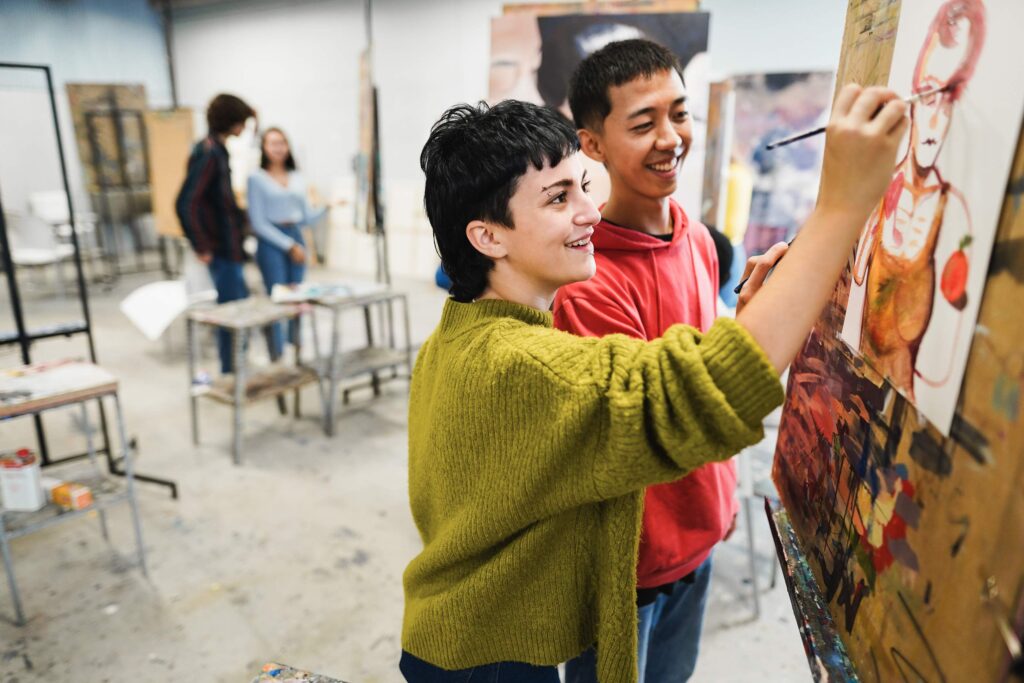Understanding Art Therapy
Art therapy is a form of therapy that utilizes the creative process to improve mental, emotional, and psychological well-being. Through the use of various art materials and techniques, individuals are encouraged to express themselves and explore their thoughts and feelings in a non-verbal and often symbolic way. In this section, we will delve into what art therapy is and the role of art therapists in facilitating this therapeutic approach.
What is Art Therapy?
Art therapy is a therapeutic modality that combines elements of psychotherapy and the creative process of art-making. It provides individuals with a safe and supportive space to engage in the artistic process as a means of self-expression and exploration. Art therapists are trained professionals who guide and facilitate this therapeutic journey.
Art therapy can take various forms, including drawing, painting, sculpture, collage, and other artistic activities. The focus is not on producing a masterpiece but rather on the process of creation and the emotions and insights that arise during that process. Through art, individuals can communicate and gain insights into their thoughts, emotions, and experiences that may be difficult to express verbally.
The Role of Art Therapists
Art therapists play a crucial role in the art therapy process. They are trained professionals with expertise in both counseling and art. They create a safe, non-judgmental, and supportive environment where individuals can freely explore their emotions and experiences through art.
Art therapists are skilled at interpreting and understanding the symbolic language of art. They help individuals explore the meaning and significance behind their artwork, facilitating self-reflection and personal growth. Through their guidance and expertise, art therapists assist clients in gaining insights, developing coping strategies, and fostering emotional well-being.
It is important to note that art therapists are not there to judge or critique the artistic skills of their clients. The focus is on the therapeutic process and the emotional and psychological benefits that can be gained through engaging in art-making. The goal is to promote self-discovery, self-expression, and personal growth.
In the next section, we will explore the numerous benefits of art therapy, including emotional expression, stress reduction, and self-exploration. To learn more about the benefits of therapy, you can visit our article on benefits of therapy.
The Benefits of Art Therapy
Art therapy offers a wide range of benefits for individuals seeking therapeutic support. Through various creative processes and artistic expression, art therapy can have a profound impact on emotional well-being and personal growth. Let’s explore some of the key benefits of art therapy.
Emotional Expression and Release
Art therapy provides a unique outlet for individuals to express and release their emotions. Through the use of various art materials and techniques, individuals can give visual form to their feelings, thoughts, and experiences. This process allows for a non-verbal and creative expression of emotions that may be difficult to articulate verbally. Art therapy can be particularly beneficial for individuals who struggle with verbal communication or find it challenging to express their emotions in traditional talk therapy sessions.
The act of creating art can provide a sense of relief and catharsis, allowing individuals to process and release pent-up emotions. Engaging in art-making can help individuals gain insight into their emotional state, identify patterns, and explore unresolved issues. By externalizing and visualizing emotions through art, individuals can experience a sense of validation and empowerment.
Stress Reduction and Relaxation
Art therapy has been found to be effective in reducing stress and promoting relaxation. Engaging in art-making can serve as a calming and meditative activity, allowing individuals to focus their attention on the creative process and the present moment. The rhythmic and repetitive motions involved in art-making can activate the parasympathetic nervous system, promoting a state of relaxation and reducing stress levels.
Creating art can also serve as a healthy and constructive way to cope with stress and anxiety. The process of art-making can distract individuals from their worries and provide a much-needed respite from daily stressors. The use of colors, textures, and shapes in art therapy can further enhance relaxation and promote a sense of tranquility.
Self-Exploration and Personal Growth
Art therapy offers individuals a unique opportunity for self-exploration and personal growth. Through the creative process, individuals can gain insights into their thoughts, beliefs, and personal experiences. Art-making provides a safe and supportive space for individuals to explore their identity, values, and aspirations.
The artwork created in art therapy sessions can serve as a visual representation of an individual’s inner world. The art therapist can guide individuals in exploring the symbolism and meaning behind their creations, facilitating a deeper understanding of themselves. This self-reflective process can lead to increased self-awareness, self-acceptance, and personal growth.
Art therapy is a versatile and effective therapeutic approach that can benefit individuals of all ages and backgrounds. By harnessing the power of artistic expression, art therapy promotes emotional expression and release, reduces stress, and fosters self-exploration and personal growth. If you’re interested in exploring the benefits of art therapy further, consider reaching out to a qualified art therapist who can guide you through this transformative process. For more information on the benefits of different therapy approaches, visit our article on benefits of therapy.
Art Therapy in Mental Health Treatment
Art therapy is a powerful therapeutic approach that can benefit individuals dealing with various mental health challenges. It offers a unique and creative way to express emotions, process trauma, and promote healing. In this section, we will explore how art therapy can be particularly beneficial for individuals struggling with anxiety and depression, trauma and PTSD, as well as substance abuse and addiction.
Anxiety and Depression
Art therapy can be an effective tool for individuals experiencing anxiety and depression. Engaging in artistic activities allows individuals to express their feelings and emotions in a non-verbal manner. Through the creation of art, individuals can explore their inner world, gain insights into their thoughts and emotions, and find new ways to cope with their symptoms.
Studies have shown that art therapy can help reduce anxiety and depression symptoms by promoting relaxation, enhancing self-esteem, and providing a sense of control and accomplishment. It offers a safe and supportive environment for individuals to process their emotions, improve self-expression, and gain a deeper understanding of themselves. This can lead to improved emotional well-being and a greater sense of empowerment.
Trauma and PTSD
Art therapy has shown great promise in the treatment of trauma and post-traumatic stress disorder (PTSD). Trauma survivors often struggle to put their traumatic experiences into words, as the memories can be overwhelming and difficult to verbalize. Art therapy provides an alternative pathway for expression, allowing individuals to communicate and process their trauma through visual imagery.
By engaging in art-making, individuals can externalize their experiences, release emotional tension, and explore their feelings in a safe and contained manner. Art therapy can help individuals regain a sense of control over their traumatic experiences and promote a gradual healing process. It can also assist in the development of healthy coping mechanisms, as individuals learn to regulate their emotions and manage distressing memories.
Substance Abuse and Addiction
Art therapy can be a valuable adjunct to traditional treatment approaches for substance abuse and addiction. It offers individuals a creative way to express their experiences, emotions, and challenges related to addiction. Through art-making, individuals can gain insight into the underlying factors contributing to their addictive behaviors, identify triggers, and develop healthier coping strategies.
Art therapy can also serve as a means of self-discovery and personal growth, helping individuals reconnect with their authentic selves and explore new avenues of self-expression. It can provide a positive and constructive outlet for emotions, reducing reliance on substances as a coping mechanism. Additionally, art therapy can enhance self-esteem, foster a sense of community and support, and promote a sense of empowerment in the recovery process.
Art therapy, when integrated into mental health treatment, can facilitate healing and transformation for individuals dealing with anxiety and depression, trauma and PTSD, as well as substance abuse and addiction. It offers a creative and non-verbal approach to processing emotions, fostering self-expression, and promoting overall well-being. If you’re interested in exploring other therapy options, you may also find our articles on benefits of cognitive-behavioral therapy, benefits of play therapy, and benefits of counseling informative.
How Art Therapy Works
Art therapy is a unique form of therapy that utilizes the creative process of art-making to promote healing and enhance mental well-being. This section will explore the therapeutic process involved in art therapy and provide examples of common art therapy techniques.
The Therapeutic Process
In art therapy, the therapeutic process involves engaging in art-making under the guidance and support of a trained art therapist. The art therapist creates a safe and non-judgmental environment where individuals can freely express themselves through art. The process typically includes the following steps:
- Assessment: The art therapist begins by conducting an initial assessment to understand the individual’s needs, goals, and preferences. This helps in designing a personalized art therapy plan.
- Art-Making: Individuals are encouraged to create art using various materials such as paints, clay, markers, or collage materials. The focus is on the process of creation rather than the final outcome. Through art, individuals can express their thoughts, emotions, and experiences in a symbolic and nonverbal manner.
- Reflection and Exploration: After creating the artwork, the art therapist engages in a dialogue with the individual to explore the meaning behind the art. This reflection helps to deepen self-awareness, gain insights, and uncover underlying emotions or conflicts.
- Integration and Interpretation: The art therapist assists individuals in interpreting their artwork, making connections between the art and their personal experiences. This process can lead to new insights, self-discovery, and a better understanding of their emotions and behaviors.
- Goal Setting and Treatment Planning: Based on the insights gained during the art therapy sessions, the art therapist collaborates with the individual to set therapeutic goals and develop a treatment plan. The goals may include improving self-esteem, managing emotions, enhancing coping skills, or fostering personal growth.
Throughout the therapeutic process, the art therapist provides support, validation, and guidance to facilitate the individual’s healing and growth. It’s important to note that art therapy is not focused solely on artistic skill or technique, but rather on the individual’s self-expression and inner experiences.
Examples of Art Therapy Techniques
Art therapy incorporates a wide range of techniques that can be tailored to meet the unique needs of each individual. Here are some common art therapy techniques:
| Technique | Description |
|---|---|
| Free Drawing | Individuals are encouraged to freely draw or paint whatever comes to mind, allowing their subconscious to guide the creative process. |
| Collage Making | Creating collages using images, pictures, and textures from magazines or other materials to represent thoughts, emotions, or desired outcomes. |
| Sculpting | Working with clay or other sculpting materials to create three-dimensional representations that can symbolize feelings or experiences. |
| Gestalt Art Therapy | Engaging in a dialogue between different elements of the artwork to gain a deeper understanding of conflicting thoughts or emotions. |
| Mask Making | Designing and decorating masks to explore different aspects of identity, emotions, or roles individuals play in their lives. |
| Guided Visualization | Using art materials to visualize and create images based on guided imagery or specific themes provided by the art therapist. |
These are just a few examples of the many art therapy techniques available. The choice of technique depends on the individual’s preferences, therapeutic goals, and the expertise of the art therapist.
Art therapy provides a powerful avenue for self-expression, exploration, and healing. By engaging in the creative process, individuals can tap into their inner resources, gain insights, and develop new coping strategies. To learn more about the benefits of therapy, including other types of therapy, visit our article on benefits of therapy.
Finding an Art Therapist
If you’re considering art therapy as a form of treatment, finding the right art therapist is essential to ensure a positive therapeutic experience. When searching for an art therapist, it’s important to consider their qualifications, credentials, and expertise in the field.
Qualifications and Credentials
Art therapists typically hold a master’s degree in art therapy or a related field, along with specialized training and supervised clinical experience. Look for art therapists who are licensed or registered by a recognized professional organization, such as the American Art Therapy Association (AATA) or the International Expressive Arts Therapy Association (IEATA).
Here are some common qualifications and credentials to look for when seeking an art therapist:
| Qualifications | Description |
|---|---|
| Master’s Degree | Look for art therapists who have completed a master’s degree in art therapy, counseling, psychology, or a related field. |
| Licensed Art Therapist (LAT) | Some states offer licensure specifically for art therapists. A licensed art therapist has met additional requirements and standards set by their state’s licensing board. |
| Registered Art Therapist (ATR) | Art therapists who have successfully completed the registration process with a professional organization, such as the AATA or IEATA, may use the designation of Registered Art Therapist (ATR). |
| Board Certified Art Therapist (ATR-BC) | Art therapists who have met the rigorous standards of the Art Therapy Credentials Board (ATCB) can earn the designation of Board Certified Art Therapist (ATR-BC). This certification demonstrates advanced knowledge and clinical skills in art therapy. |
When researching potential art therapists, verify their qualifications and credentials to ensure they meet the necessary standards to provide professional art therapy services.
Choosing the Right Art Therapist for You
Finding the right art therapist is a personal process that involves considering your specific needs, goals, and preferences. Here are some factors to consider when choosing an art therapist:
- Specialization: Some art therapists specialize in working with specific populations, such as children, adolescents, adults, or individuals with particular mental health conditions. Consider whether you would benefit from an art therapist with expertise in your specific area of concern.
- Approach: Art therapists may have different therapeutic approaches and techniques. Research different approaches, such as person-centered, psychodynamic, or cognitive-behavioral art therapy, to identify which aligns with your preferences and goals.
- Experience: Look for art therapists with experience in the areas you wish to address. Consider their years of experience, types of clients they have worked with, and the specific issues they have helped clients navigate.
- Compatibility: Building a trusting and comfortable relationship with your art therapist is crucial for the success of therapy. Consider factors such as gender, age, and cultural background to ensure you feel at ease and understood during the therapeutic process.
Before making a final decision, it can be helpful to schedule initial consultations or phone calls with potential art therapists to discuss your needs, ask questions, and gauge whether you feel a connection. Remember, finding the right art therapist is an individual process, and it’s important to choose someone who makes you feel supported and understood.
Art therapy can be a transformative and healing journey, and with the right art therapist by your side, you can embark on a path of self-discovery and personal growth.







